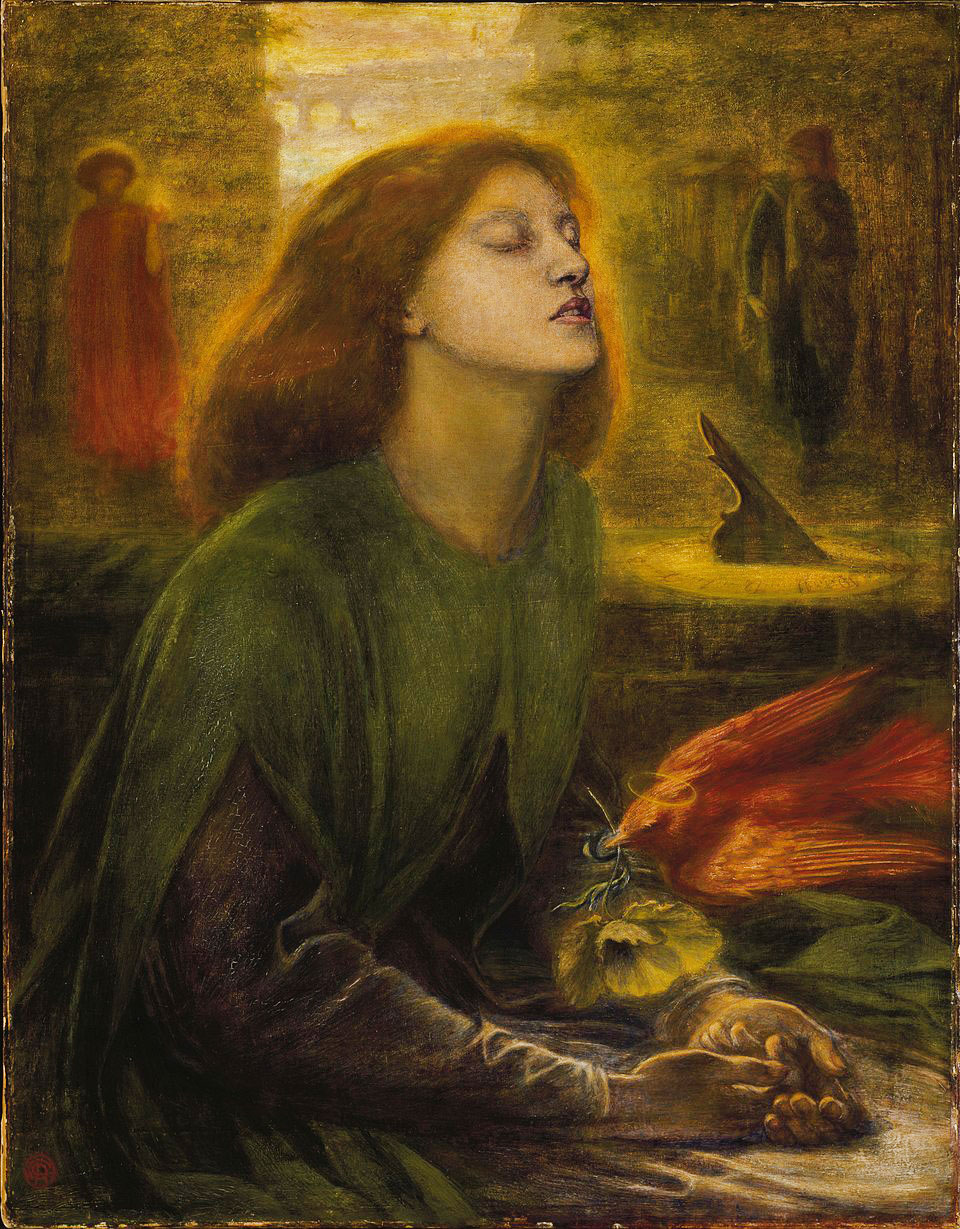
Beata Beatrix: A Love Enshrined in Paint
In the golden haze of Victorian England, where art and poetry danced in shadow and light, Dante Gabriel Rossetti conjured a painting not merely with oils and brushes, but with grief, love, memory, and mysticism. That painting was Beata Beatrix.
At first glance, the work may seem like a traditional pre-Raphaelite rendering of a beautiful woman. But like all great art, its meaning unfurls slowly, layer by layer, like a rose blooming in twilight. Beata Beatrix is more than an image; it is a story, a vision, and an elegy. It is a visual requiem born from the heart of a man mourning his lost muse.
Who Painted Beata Beatrix?
Beata Beatrix was painted by Dante Gabriel Rossetti (1828–1882), one of the founding members of the Pre-Raphaelite Brotherhood. A poet and painter, Rossetti was deeply influenced by medievalism, symbolism, and romantic literature, particularly the works of Dante Alighieri.
Rossetti was not just an artist in the conventional sense; he was a dreamer who wove tapestries of longing, allegory, and desire into his work. And of all his paintings, Beata Beatrix stands as perhaps his most personal and emotionally resonant.
The Woman in the Painting: Elizabeth Siddal
The central figure in Beata Beatrix is modeled after Elizabeth Siddal, Rossetti’s muse, wife, and the tragic inspiration behind much of his work. Siddal was more than just a model; she was a gifted artist and poet in her own right, a woman of striking presence who captivated Rossetti and the entire Pre-Raphaelite circle.
Their relationship was passionate, tumultuous, and haunted by illness and addiction. Siddal suffered from poor health throughout her life and became dependent on laudanum, a powerful opiate commonly used in the 19th century. In 1862, only two years into their marriage, Siddal died of a laudanum overdose, likely a suicide. Her death devastated Rossetti and became the driving force behind Beata Beatrix.
What Is the Meaning of Beata Beatrix?
Beata Beatrix is not a portrait in the traditional sense. It is, instead, a poetic and spiritualized vision of Elizabeth Siddal at the moment of her death, transformed into the figure of Beatrice Portinari, the beloved of Dante Alighieri.
Beatrice, in Dante’s Divine Comedy, is the soul who guides Dante through Paradise. She represents divine love and spiritual salvation. Rossetti merges this celestial Beatrice with his own Beata, Elizabeth. In doing so, he elevates Siddal from mortal suffering to immortal grace. The painting becomes an allegory of death not as an end, but as a transcendence.
Siddal is depicted with her eyes closed, her face serene, as if in a state of ecstasy or deep meditation. Her hands rest in her lap, passive and relaxed. A red dove flies toward her, holding a white poppy in its beak, symbolizing both love and death, and perhaps laudanum itself. In the background, a shadowy figure of Dante watches, representing the artist himself in mourning.
The palette is suffused with a warm, glowing golden light, suggesting the eternal sunset of passing into the afterlife. Time seems suspended, caught between the breath of life and the silence of death.
Rossetti once described the painting as a “vision of Beatrice at the moment of death, when she is transfigured by spiritual presence.” That moment, frozen forever on the canvas, is not one of despair but of release. It is a moment Rossetti hoped for Siddal, and perhaps longed for himself.
What Type of Art Is Beata Beatrix?
Beata Beatrix is a quintessential example of Pre-Raphaelite art, an artistic movement founded in 1848 by Rossetti, William Holman Hunt, and John Everett Millais. The movement sought to return to the detailed, vivid, and symbolic qualities found in early Renaissance painting before the influence of Raphael.
The Pre-Raphaelites rejected the academic art establishment and embraced an aesthetic that emphasized:
Symbolism: Every element in Beata Beatrix is symbolic, from the poppy to the dove to the hourglass in the background.
Literary Influence: Rossetti’s love of Dante Alighieri’s poetry shapes the painting’s narrative and title.
Medievalism and Mysticism: The painting has a dreamlike, timeless quality that feels medieval rather than Victorian.
Emotional Intensity: The painting drips with emotion, longing, loss, hope, and transformation.
It also belongs to the category of symbolist art, in which the literal meaning is less important than the emotional or spiritual resonance. In Beata Beatrix, the scene transcends realism. The viewer is invited not just to look, but to feel.
When Was Beata Beatrix Painted?
The original version of Beata Beatrix was painted between 1864 and 1870, two years after Elizabeth Siddal’s death. Rossetti worked on it intermittently over those six years, refining not just the technical details but the emotional nuance of the piece. It was never meant to be a straightforward tribute; rather, it was a spiritual labor of grief, an artistic ritual of mourning.
But Rossetti did not stop with one version. He later painted multiple versions of Beata Beatrix, each with slight variations. A second major version was completed in 1877, in which he added more overt Christian iconography and softened some of the original’s more mystical elements.
What Is the Size of Beata Beatrix?
The original Beata Beatrix painting, which is housed in the Tate Britain in London, measures 86.4 cm x 66 cm (34 in x 26 in). It’s not a large canvas, yet its intimate scale intensifies the personal and meditative quality of the work. It invites close, reverent viewing, more like a shrine than a gallery piece.
The painting’s size mirrors its theme: this is not a grand narrative scene; it is a quiet moment of transformation, best experienced up close and in stillness.
A Painting Beyond Time
To understand Beata Beatrix, one must look not just with the eyes, but with the heart. This is not a painting that shouts its meaning, it whispers, like a prayer.
It is about love and loss, but also about transcendence and idealization. Rossetti was not only grieving Elizabeth’s physical death; he was trying to preserve her spirit. In fusing her image with Dante’s Beatrice, he gives her eternal life, not in heaven alone, but in art.
It is no coincidence that Rossetti placed a volume of his poems in Siddal’s coffin after her death. Years later, he had her body exhumed to retrieve the manuscript, a controversial act that reflects the depth and complexity of his mourning. But Beata Beatrix is his truest elegy. Here, he does not retrieve her, he releases her.
The Legacy of Beata Beatrix
Today, Beata Beatrix stands as one of the most enduring icons of Victorian art. It has inspired countless interpretations in art history, poetry, and popular culture. Its mystical atmosphere, poignant symbolism, and tragic backstory lend it an aura of sacredness.
Rossetti’s blending of personal emotion with literary and spiritual allusion helped redefine what art could be. No longer just a replication of the world, it became a vehicle for expressing the inner life, the soul, the ache, the yearning.
In many ways, Beata Beatrix encapsulates the Victorian preoccupation with death and the afterlife. But unlike the morbid fascination that characterized much of the era’s mourning culture, Rossetti’s painting offers solace. It doesn’t dwell on decay; it dreams of redemption.
Beata Beatrix is a love story, a lament, and a vision. Painted not in the colors of life, but in the light of memory, it remains one of Dante Gabriel Rossetti’s most haunting and sublime achievements.
To view Beata Beatrix is to step into a liminal space, somewhere between past and future, life and death, dream and reality. It is to hear the soft beat of a heart stilled in sorrow and stirred by the hope of reunion.
In that eternal moment captured on canvas, Elizabeth Siddal becomes Beatrice. And in painting her, Rossetti becomes Dante, forever chasing his love through the shadowed corridors of memory and the luminous halls of art.




